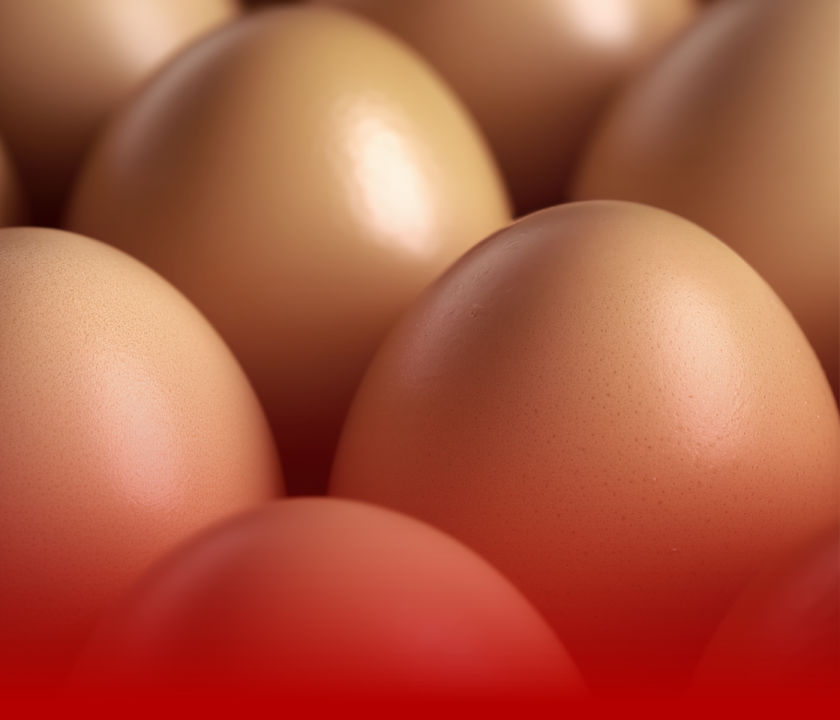Content available at: Indonesia (Indonesian) Melayu (Malay) ไทย (Thai) Tiếng Việt (Vietnamese) Philipino
Nesting systems are designed to maximize the production of clean, settable eggs that are free of contamination and have not been exposure to moisture.
Unfortunately, a producer will occasionally have a flock that will reject the nests and lay eggs outside the nests (in the litter or on slats).
In extreme cases, if a significant portion of the flock is laying outside the nest, hatch performance and chick quality can suffer. Moreover, the collection of floor eggs requires extra labor and creates biosecurity risks in the hatchery.
- Once hens begin laying eggs outside the nest, it is very difficult to change the behavior.
BREAK HABITS BEFORE THEY BEGIN
Though floor eggs are a problem during the production period, there are management practices during rearing that can prevent floor eggs. In some cases, birds cannot easily access the nests because they did not learn how to jump in rearing.
Enrichments in rearing are a viable option to teach the bird how to climb and jump.
- Choosing the right type of perch is also very important. If the birds are going to be transferred to an mechanical nest box system, choose flat perches (not A-type perches), preferably manufactured with the same slats (perches) as those found in production.
This will encourage the birds to jump up directly and quickly get accustomed to the new production layout.
Image 1. Walk through the flock slowly and calmly during rearing to stimulate bird movement and mobility. Continue the practice in production to help prevent hens laying eggs in the litter.
Positioning slat-type perches under one nipple line will also encourage jumping and create a positive association between jumping up on the slats and drinking. The height of the slats must be no higher than 45 cm.
Feeder type can also impact mobility. With pan feeders, the bird travels underneath pan feeder.
- Chain feeders in rearing stimulate mobility, but must be set low enough to encourage pullets to jump over the track.
- When pan feeders are used in rearing, it is encouraged to incorporate enrichments. Enrichments can be implemented at placement with access ramps.
Image 2. If feeders are installed on the slats, ensure the height is correct so that hens can easily go over the feeders to access nests.
Light intensity may also lead to future floor egg problems. Very low light intensity (<1 lux) during rearing can reduce bird activity.
- Therefore, light intensity should be maintained at a level that allows farm workers to perform normal duties and are high enough to promote bird activity (2 to 5 lux).
- Note that light intensity in rearing over lux 5 can negatively affect female photo stimulation.
MAKE NESTS ATTRACTIVE AND EASILY ACCESSIBLE
Hens need to feel safe when laying eggs and will search for relatively dark areas to lay eggs. They are more likely to lay eggs in dark spots instead of the nest boxes which may be further away.
- Therefore, prevent shadowed areas with uniform lighting and ensure there are no shadows next to the slat ends and no direct light shining on the nest boxes.
Too much bedding on the floors may encourage hens to lay eggs outside the nest. Keep bedding height at 4 to 6 cm depending on the house setup and nest type.
Feeders and drinkers should never prevent access to nest boxes. Hang feeders at heights that allow the birds to pass under them or go over them placed directly on the slats. Ensure drinker heights, bird per nipple and pressure are correct.
Image 3. red mites
Hens may crowd around drinker lines if water access is insufficient and block nest entrances. Producers should always follow the manufacturers’ technical directions and
not limit or exceed the suggested numbers of drinkers per bird.
- Air drafts directed at the nest box opening instead of the roof can disturb the birds and cause them to leave the nests. Ensure that all ventilation settings and air movement is directed in the correct position.
Interiors of the nest boxes should be clean and parasite free. Ectoparasites, such as red mites, can disturb the hens and cause them to avoid nests. It is recommended to remove and wash soiled pads, then allow them to dry thoroughly before re-using.
- Having a small surplus of pads (about 20%) on hand, will allow immediate replacement of soiled pads and prevent leaving nests without a pad.
MINIMIZING AND TROUBLESHOOTING
Typically a floor egg ratio above 2% suggests a problem or that improvements need to be made. Collect floor eggs regularly so that the birds have minimal opportunity to associate eggs with the litter.
- Collect floor egg 4 times per day until the flock is 27 weeks of age. Walking patterns are also useful to deter females from laying in corners or on the floor.
Determine if hens are having difficulty accessing the nests. If jumping seems to be a challenge check slat height (should be 45 cm or lower) and consider installing ramps as a quick solution.
- Check water availability and determine if hens are crowding around nipple lines and blocking access to nests.
Ensure that there are a sufficient number of nests available. Since about 80 % of the flock will lay eggs within the same time frame, nest boxes can get crowded. Hens that cannot easily find a space will tend to lay in the floor.
CONCLUSIONS
It is important to proactively manage floor egg production. Train pullets early in rearing with an emphasis on good mobility. Ensure the nest boxes in production are attractive and easy to access.
- If floor eggs do occur, the location and timing can provide clues about why the hen chose to lay on the floor rather than the nests.
Good observation and taking action at the first sign of floor egg production can help mitigate the issue early in production.
PDF
